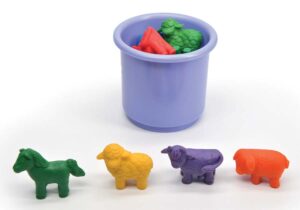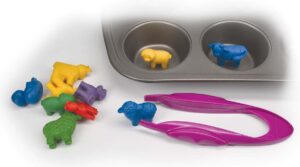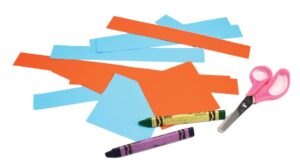Fine motor development
Toddlers practice a pincer grasp in arranging toy animals in a line for a pretend parade.




Be Prepared: Secure plastic storage containers or similar items for distributing the toy animals to toddlers and providing fine motor practice in grasping and removing small toys from a container. Distribute toy animals equally into the containers. One of the containers is for demonstration. Secure a tambourine, bell, or other type of sound-making item to provide a festive experience at the pretend parade. Offer the activity at a low table that provides adequate space for each toddler to form a line of toy animals.
[Invite 3–4 toddlers to help toy animals get ready for a parade. Put containers with animals near you.]
Let’s help our toy animals get ready for a parade! People march or walk on a street or road for a parade.
[Engage toddlers in discussion of a parade. Help toddlers describe a parade they may have shared, such as a parade in your community or maybe a parade of children on a special day in your center.]
[Point to the containers.]
There are toy animals in these containers. Each of us will get a container. We can take the animals out of the container and put them in a line for our parade. Each of us can make our own line of animals for the parade.
I can show you one way to put the toy animals in a line for a parade.
[Demonstrate and describe taking toy animals out of a container, one at a time. Use a pincer grasp by picking up each toy animal with your thumb and first or middle finger. Draw attention to your use of a thumb and a finger for picking up each toy animal.
 Say the name and/or color of each animal. Put the toy animals in front of you for the purpose of deciding which animal will go first in your parade line. Explain the plan. Example: “I want to look at all of my animals. I want to pick one animal to be at the beginning of my parade.” Explain that the animal at the beginning of the line is the leader of the parade.
Say the name and/or color of each animal. Put the toy animals in front of you for the purpose of deciding which animal will go first in your parade line. Explain the plan. Example: “I want to look at all of my animals. I want to pick one animal to be at the beginning of my parade.” Explain that the animal at the beginning of the line is the leader of the parade.
Then move the toy animals into a line. Again emphasize your use of a thumb and finger to pick up each toy animal. Emphasize how you are putting the animals in a line. The line of animals is on a pretend road.
Example: “I think I will put the horse at the beginning of the line for my parade. The horse goes first. The horse is the leader of my parade. I am using my thumb and finger to pick up the horse.”]
[Give each toddler a container. Encourage toddlers to remove the toy animals, one at a time, with thumb and finger. Offer verbal support for removing one toy at a time, as appropriate.
After a toddler has removed all toy animals, ask him/her which animal he/she will put at the beginning of the line. Example: “Amber, which animal will be the leader of your parade?”
Encourage toddlers to place animals in a line. The direction of a line is a toddler’s choice. It is not necessary for toddlers to coordinate their lines.
Repeat and extend a toddler’s comments. Example: “Pig. The pig is the first one in your line. Pig is the leader!”
Offer parade music/excitement when each toddler has several or all animals lined up for a parade. Make up and sing a little song and use the sound maker! Use a tune to a song you know, or improvise using the “ABC” tune. Toddlers will not mind if the lyrics do not rhyme. The intent is to create a festive experience. Point to each line of animals as you sing. Clap. Say “hooray.” Encourage toddlers to join you in moving arms in the air.
If time and toddler interest permit, toddlers may wish to (1) move their animals so they walk or march in the opposite direction, and/or (2) move the position/direction of their line. Both of these actions provide more practice with a pincer grasp.]
Parades are fun! Each of us took toy animals out of a container and decided which animal should lead our parade. Then we put our animals in a line and sang about our parade.
In the opening segment’s discussion of a parade, look for whether each toddler seems familiar with a parade. Toddlers will be more likely to engage and enjoy the activity if they have a concrete image of a parade.
The activity provides opportunities for at least two experiences with a pincer grasp. The size of the toy animals will naturally foster a pincer grasp. Support each toddler’s existing skill. Some toddlers may grasp an animal with their entire hand. Some may find it challenging to put the animals in a line (see Extra Support tip). Be flexible about toddlers’ fine motor approaches to the activity while also taking note of toddlers who may need more opportunities to practice fine motor skills.
Some toddlers may be more interested in color than type of animal. A red animal may be their choice to lead their parade, for example. Toddlers may need help naming types of animals.
It takes time to develop fine motor skills and toddlers will differ in their current abilities, as suggested above. Maintain a focus on the fine motor aspects of the current activity without imposing pressure or creating stress. Coordination of small muscles in the hands and fingers is important for many daily tasks, such as using a fork or spoon, stringing beads, moving puzzle pieces, writing, and cutting. Fine motor skills are one key to independence because they are needed for getting dressed, opening containers, and manipulating small toys.
Extra support
Enrichment
Fine motor development
Toddlers practice using tongs to move small toys to a muffin pan.



Be Prepared: Secure toddler-size tongs (sometimes called jumbo tweezers) that work best by using a whole hand, not fingers only. A tong that is less than four inches in length may be too small for whole hand use. Some toddlers may be ready to manipulate larger-size tongs. It is helpful for tongs to be the same size. Secure muffin pans with 6–8 openings. Provide each toddler with as many counters as muffin openings. Offer the activity at a low table.
 Invite up to four toddlers to join you in playing with tongs and jumbo animal counters. Give each toddler a set of counters, tongs, and a muffin pan. Explain each item, including how to hold and use tongs. The challenge is to use the tongs to pick up jumbo animal counters, one at a time, and place each counter in one muffin opening. Demonstrate and describe the activity. Draw attention to separate actions in using the tongs to pick up and then let go of a counter. Encourage toddlers to move their counters to the muffin pan, one at a time. Provide verbal support for each action as appropriate. Emphasize that we put one counter in one muffin opening. Toddlers may also enjoy taking the animals out of the muffin tin with the tongs.
Invite up to four toddlers to join you in playing with tongs and jumbo animal counters. Give each toddler a set of counters, tongs, and a muffin pan. Explain each item, including how to hold and use tongs. The challenge is to use the tongs to pick up jumbo animal counters, one at a time, and place each counter in one muffin opening. Demonstrate and describe the activity. Draw attention to separate actions in using the tongs to pick up and then let go of a counter. Encourage toddlers to move their counters to the muffin pan, one at a time. Provide verbal support for each action as appropriate. Emphasize that we put one counter in one muffin opening. Toddlers may also enjoy taking the animals out of the muffin tin with the tongs.
Transferring items into the muffin cups will be enjoyable for toddlers and may provide a sense of self-satisfaction. Some toddlers may complete the activity once and show no interest in more use of the tongs. Other toddlers may prefer to repeat the activity. Use of tongs can strengthen hand muscles and eye-hand coordination. The current activity also supports early awareness of one-to-one correspondence, an important cognitive skill that is part of later competence in math. If a toddler places more than one counter in a muffin opening, gently remind the toddler that we put one counter in one opening; we want to fill all the openings in the muffin pan.
A toddler may use two hands to manipulate the tongs. This approach can support practice in eye-hand coordination and in figuring out how much pressure to use in picking up and moving a toy with tongs. A toddler may move one of the arms of the tongs while holding the other arm still, for example. With repeated practice and opportunity to watch use of tongs with one hand, a toddler is likely to begin using one hand.
Generally small tongs work well for toddlers. See Extra Support tips if use of tongs is challenging. This activity extends a Block 20 (Physical/Health) activity that involves use of tongs.
Extra support
Enrichment
Fine motor development
Toddlers interested in using scissors practice early cutting skills.



Be Prepared: This activity is for toddlers who show interest in using scissors. Limit the activity to two toddlers so individualized support can be offered to each participant. Cut the colored paper into three-inch squares and also strips about an inch wide or less. Triangle-shaped crayons foster a good pincer grip. Set up a table activity with crayons and drawing paper. Keep the scissors and strips of paper near you for introduction at an appropriate time during the activity.
Invite 1–2 toddlers to the table to make marks or scribbles on drawing paper or the colored squares. Sit or kneel at eye level and talk with each toddler about his/her scribbles and lines. Encourage toddlers to make any type of mark or scribble.
As toddlers seem to be nearing the end of marking marks with a crayon(s), offer to help each child use scissors. If a toddler(s) shows interest, demonstrate use of toddler-size scissors. Begin snipping the edges of a small paper square with the scissors. Grasp the scissors with your thumb in the upper hole and your first two fingers in the larger, lower hold. Say “thumb up to cut.” Describe your actions to create interest in the scissors. Example: “I am cutting some lines in this paper. I open and close the scissors. My scissors go snip, snip, snip.”
If a toddler is ready to try using the scissors, provide a pair of scissors and encourage the toddler to hold the scissors in a hand of his/her choice. Support first use of scissors with one toddler at a time. A second toddler at the table can continue to color or watch you support the other toddler in using scissors. One-to-one support is necessary for most toddlers to develop hand/finger movement and coordination with scissors.
 Encourage a toddler to try to open and close the scissor blades. The challenge is to control the scissors with the right amount of pressure on the handles. If the toddler is able to open and close the scissors, hold a small paper square rigid with both hands at a good level for the toddler. Encourage the toddler to make snips along one edge of the paper.
Encourage a toddler to try to open and close the scissor blades. The challenge is to control the scissors with the right amount of pressure on the handles. If the toddler is able to open and close the scissors, hold a small paper square rigid with both hands at a good level for the toddler. Encourage the toddler to make snips along one edge of the paper.
If a toddler holds the scissors with a rotated wrist, ask if you may turn his/her hand. Gently turn the toddler’s hand so the thumb is upward and the fingers are downward. Help a toddler remember the correct hand position by saying “thumb up to cut.”
Provide the thin strips of paper to a toddler who can snip with one hand. Encourage the toddler to hold scissors in one hand and hold the paper strip with the opposite hand. Toddlers will enjoy the process of making a pile of tiny paper pieces.
Toddlers with interest in using scissors generally enjoy cutting strips or small pieces about the size of their palm. Toddlers are not expected to cut across a sheet or paper or to cut any particular shape. If cutting with scissors is difficult for a toddler, provide a simple hand paper punch and demonstrate how to punch holes. Using the punch can strengthen a toddler’s hand and offer the feeling of a cutting motion.
Extra support
Enrichment
Materials Needed: toddler-size tongs, shredded paper or tissue paper, block area props, jumbo farm animals, books about farm animals such as Big Red Barn by Margaret Wise Brown
Extend Option 2 by setting up a make-believe farm in the sensory table with shredded paper or tissue paper, and other materials from the block area. Encourage toddlers to use tongs to pick up animals. Share with toddlers books related to animals that might be found on a farm, such as Big Red Barn by Margaret Wise Brown.
Materials Needed: scissors, plastic bowl, shoelace, strips of paper, books, small toys, squirting bath toys and bottles
In addition to offering the activity options, consider creating a cutting station for toddlers and preschool-age children who have scissor skills. Use small, blunt, toddler-size scissors. Attach scissors to a plastic bowl with a shoelace. The bowl provides a place for “catching” small pieces of paper a child cuts from a somewhat larger piece of paper.
Toddlers and preschool-age children will enjoy squirting bath toys in a sensory table or bin. A pincer grasp and release will fill the squirt toy with water; a second pincer squeeze squirts water out. Squirting bottles in water fosters hand strength and dexterity.
Foster fine motor development for mobile infants by encouraging them to point to pictures in books and to grasp small toys.